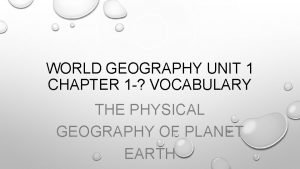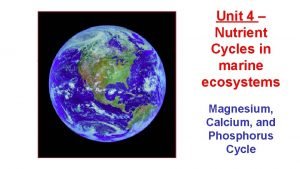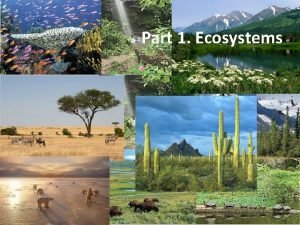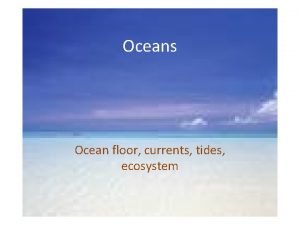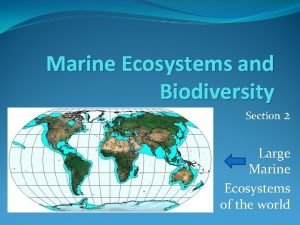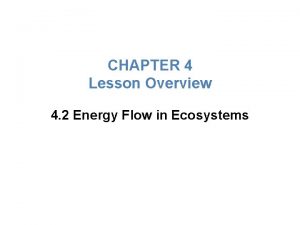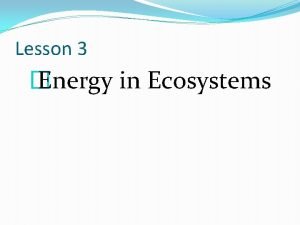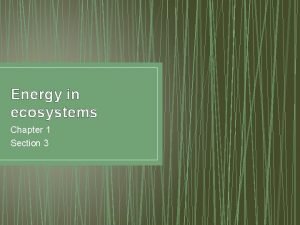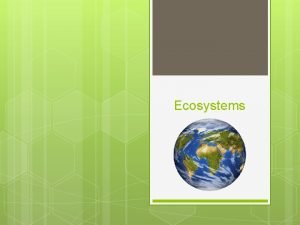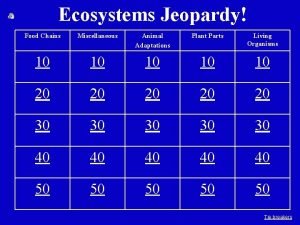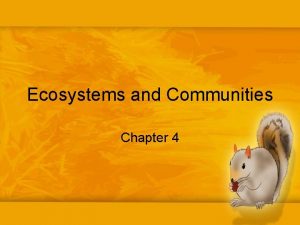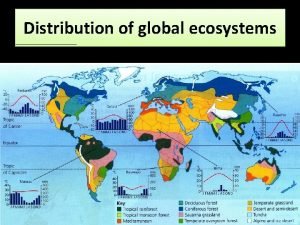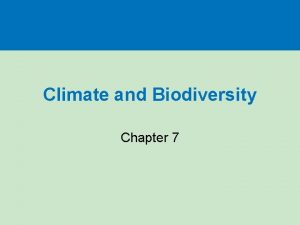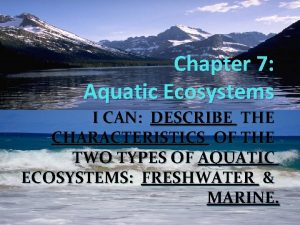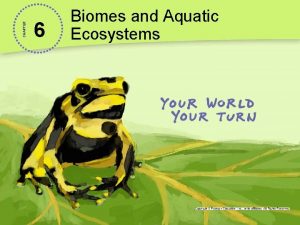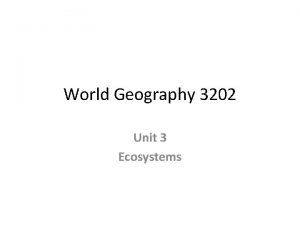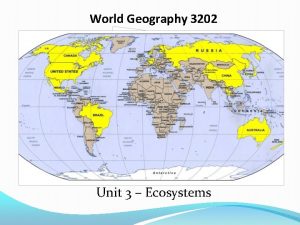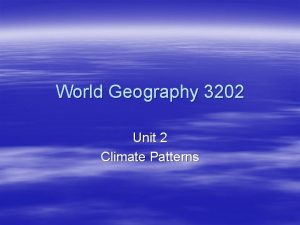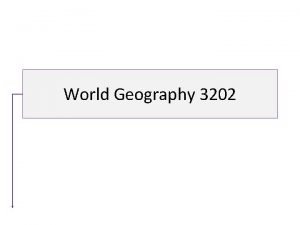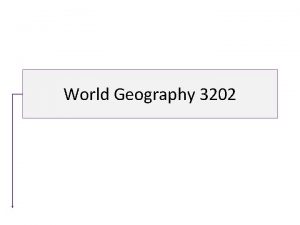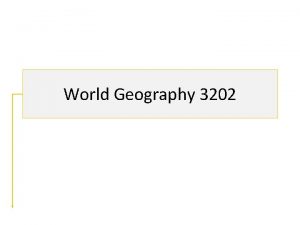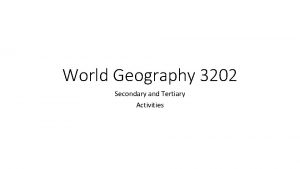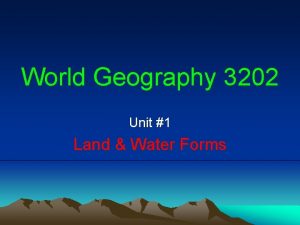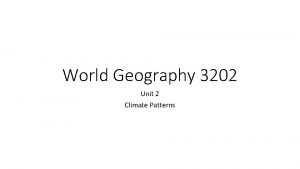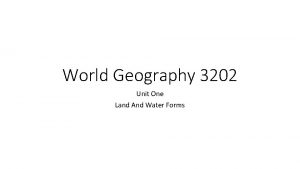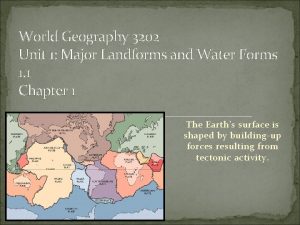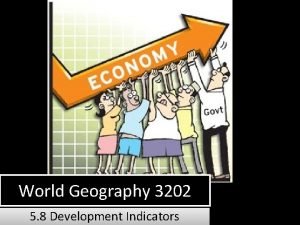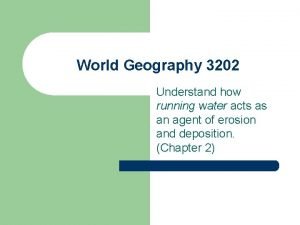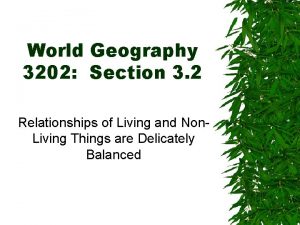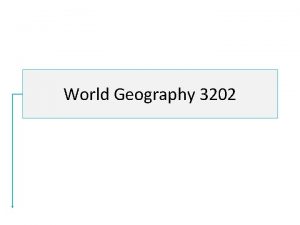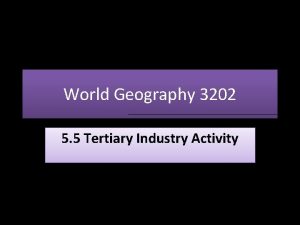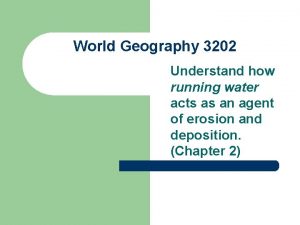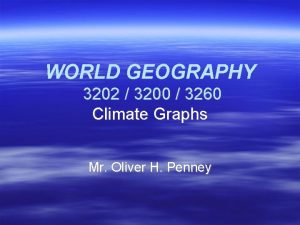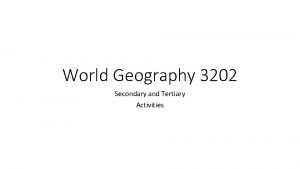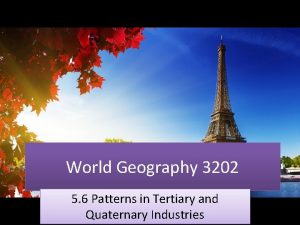World Geography 3202 Unit 3 Ecosystems Introduction n






























- Slides: 30

World Geography 3202 Unit 3 Ecosystems

Introduction n Unit 3 focuses on the interrelationships between landforms and water forms on the one hand climate on the other, and how these interrelationships make up the earth’s ecosystems. Soils, which result from a complex interaction among climate, land, flora and fauna, form a vital resource that humans use to satisfy needs and wants. Humans must exercise wise stewardship in order to conserve resources

An ecosystem consists of a complex network of organisms Ecosystem: The network of relationships among plants, animals and the non-living constituents in the environment. n It is composed of: n Producers: Organisms capable of making their own food supply from solar energy, thus making them necessary for supplying the energy for all of life. n Consumers: Animals that must eat producers and other consumers in order to survive n

An ecosystem consists of a complex network of organisms n Decomposers: Live in soil or water and include bacteria, fungi, and mold. n n They break down wastes of other consumers and the decaying tissue of dead organisms into basic chemical compounds and nutrients. These decomposed substances are returned to the environment to be reused by plants for growth and food production. Primary Consumers: Herbivores, those animals whose only source of energy is green plants. Secondary Consumers: Those organisms who survive on the energy of producers and primary and secondary consumers

Ecosystem

An ecosystem consists of a complex network of organisms n Starting with the sun, sending it’s energy to plant producers, and continuing on through every instance of one organism consuming another, energy is constantly begin transferred, or passed on, through life forms. n This transference is called a Food Chain

An ecosystem consists of a complex network of organisms n A food chain is relatively simplistic, often with five links or less: n n n Producer --- Primary Consumer --- Secondary Consumer -- Tertiary Consumer In most ecosystems, there are many overlapping food chains, because most organisms obtain energy from different sources. Consequently, the relationship of organisms in competition for various energy sources in a given ecosystem is better described as a Food Web

Food Web

Energy flow through an ecosystem n n n Solar Energy is delivered to plants Plants deliver oxygen to atmosphere, take in Carbon Dioxide, and serve as food for Primary Consumers are consumed by Secondary Consumers Secondary by tertiary, and so on… At each level of transference, energy is lost: only 10 to 15 percent of the energy used by the food source is consumed by the next level… Therefore secondary and tertiary consumers are terrible energy wasters

Energy flow through an ecosystem

Food Pyramids n n n The food pyramid diagram can be used to illustrate energy flow in food chains and food webs. The pyramid shape of the diagram derives from the fact that a steadily decreasing amount of energy is available at each new level in the food chain. As a result of competition, the number of organisms that can be supported at each new level decreases.

Food Pyramids

Food Pyramids n n The base of the pyramids represents the amount of energy supplied by all the plants or producers in an ecosystem. The layer above the base represents the number of primary consumers that can be supported by the producers The layering continues until, in theory, only one carnivore can be supported at the top. Each of these layers is known as a Trophic Level.

The relationships among the living and non-living elements of an ecosystem are delicately balanced n Biological Amplification : n n When consumers at higher levels in a food chain eat organisms that have toxic chemicals in their tissues, they receive a higher concentration of the toxins than did the lower level organisms. Two factors are involved in this magnification. n n First: Toxic chemicals are fat soluble. This means they collect in fatty tissues and do not get flushed with waste. Second: The higher up the food chain an organism is, the more of organisms it has to consume to keep energy levels up, as it only receives approximately 10 percent of that organism’s energy in transference.

Predict the effect on an ecosystem of the introduction of a new organism n In groups, complete question 13, p. 99

The general characteristics of a given ecosystem All life forms seem to be specially suited to the physical characteristics of the ecosystem that they inhabit. n The one feature that is most essential for identifying a given ecosystem is its climax vegetation – The chief vegetation that has developed in a region over a long period of time, given a particular climate. n

The general characteristics of a given ecosystem

The general characteristics of a given ecosystem

The general characteristics of a given ecosystem

n The factors that affect soil quality : n Soil develops from a complex interaction of several processes occurring over centuries.

The quality of a soil in terms of its soil texture n Soil quality or fertility is measured in terms of a soil’s hums content relative to the amount of ground-down bedrock it contains. The key factor that causes variance in soil profiles is climate n Climate provides the moisture needed for the weathering process at the beginning of soil formation, as well as the precipitation and dry heat needed for leaching, eluviations and capillary action to occur. n

The quality of a soil in terms of its soil texture n A key component in determining a soil’s value is its texture. n Texture refers to the types of particles in the soil n Both particle size and the extent to which particles bond to one another affect soil quality. n These characteristics of particles determine how much water will flow through the soil, the water holding capacity of the soil, and air movement through the soil.

The quality of a soil in terms of its soil texture §The three smallest components, Sand, Silt, and Clay, are the principal components of soil. §At one extreme, Sandy soil, is loose and coarse. Water and air penetrate easily, making for easy drainage and rapid warming. It is so loose, however, that moisture needed for large scale plant growth is not retained. §The other extreme is clay soil, which consists of fine grains of silicate material containing aluminum and water. This tends to hold water like a sponge and does not permit air to pass through. The soil is slow to warm up, slow to drain and hard to work.

The quality of a soil in terms of its soil texture n The most desirable soil texture for farmers is a balanced combination of soil, clay and silt particles, forming loam.

Global patterns related to soil loss

Global patterns related to soil loss n Certain regions enjoy more fertile soil than others. n n n The most common cause of soil loss is water run-off. n n However all regions are subject to soil degradation Soil can be degraded or lost in a very short period of time Other factors include urban expansion, overgrazing, flooding, and deforestation Desertification: The degradation of land into arid and semi arid states through careless land use such as overgrazing.

Global patterns related to soil loss §Based on this chart, where is the loss of soil the greatest? The least?

Global patterns related to soil loss

Assess statements about soil availability In Africa Only 16 per cent of the land is suitable for farming n In Southern Asia Only 20 per cent of the land is suitable for farming n In Central and Northern Asia Only 10 per cent of the land is suitable for farming n In Europe a fairly large amount of the soil is suited to farming n

Possible short-term and long-term impacts of a threat to an ecosystem n Examine the case studies on pp. 117 - 129 for various reasons for threats to ecosystems, the causes for the threats and the results.
 World geography unit 9 lesson 1
World geography unit 9 lesson 1 World geography unit 1 test
World geography unit 1 test World geography unit 1 vocabulary
World geography unit 1 vocabulary Unit 10, unit 10 review tests, unit 10 general test
Unit 10, unit 10 review tests, unit 10 general test Ap human geography frqs
Ap human geography frqs 5 themes of geography ap human geography
5 themes of geography ap human geography Stateless nation
Stateless nation Water contamination introduction
Water contamination introduction Marine magnesium cycle
Marine magnesium cycle Lesson outline lesson 2 aquatic ecosystems answer key
Lesson outline lesson 2 aquatic ecosystems answer key Section 3 aquatic ecosystems worksheet answers
Section 3 aquatic ecosystems worksheet answers Ecosystem living and nonliving things
Ecosystem living and nonliving things Objective of ecosystem
Objective of ecosystem Shark food chain
Shark food chain Ecosystems examples
Ecosystems examples Chapter 4 lesson 2 energy flow in ecosystems answer key
Chapter 4 lesson 2 energy flow in ecosystems answer key Which marine ecosystem contains the fewest producers
Which marine ecosystem contains the fewest producers Interactions in the environment grade 7
Interactions in the environment grade 7 Section 3 energy in ecosystems
Section 3 energy in ecosystems Climatespongy
Climatespongy Biotic factors in an ecosystem
Biotic factors in an ecosystem Food chain jeopardy
Food chain jeopardy Chapter 4 ecosystems and communities
Chapter 4 ecosystems and communities Distribution of global ecosystems
Distribution of global ecosystems Human impact on terrestrial ecosystems
Human impact on terrestrial ecosystems What are the two main types of aquatic ecosystems
What are the two main types of aquatic ecosystems The chaparral biome is best characterized by _______.
The chaparral biome is best characterized by _______. Biomes and aquatic ecosystems
Biomes and aquatic ecosystems Chapter 55 ecosystems and restoration ecology
Chapter 55 ecosystems and restoration ecology Chapter 42 ecosystems and energy
Chapter 42 ecosystems and energy Chapter 3 lesson 3 biomes and aquatic ecosystems
Chapter 3 lesson 3 biomes and aquatic ecosystems


